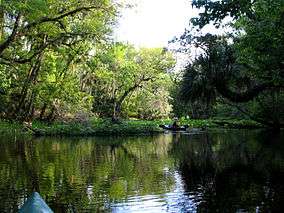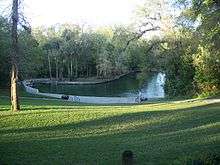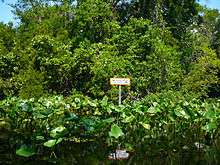Wekiva River
The Wekiva River (sometimes spelled Wekiwa, a Creek word meaning "spring of water"[2]) is a 16.0-mile-long (25.7 km) river in Central Florida, north of Orlando in the United States. It originates in Apopka and joins the St. Johns River, the longest river in the state, in DeBary. The Wekiva River system includes the main stem joined by three main tributaries - Rock Springs Run, Blackwater Creek, and the Little Wekiva River - and about 30 contributing groundwater springs.[3] It is designated as a Florida State Canoe Trail, an Outstanding Florida Water, and an Aquatic Preserve by the Florida Department of Environmental Protection.[4] The Wekiva River system is also one of the two rivers in Florida federally designated as a National Wild and Scenic River for its scenery, recreation, geology, and diverse habitats.[5]
| Wekiva River Wekiwa | |
|---|---|
 Canoeing on the Wekiva River | |
 Location of the mouth in Florida  Wekiva River (the United States) | |
| Location | |
| Country | United States |
| State | Florida |
| Counties | Orange, Lake, Seminole |
| Physical characteristics | |
| Source | Wekiwa Springs |
| • location | Apopka, Florida |
| • coordinates | 28°42′42.80″N 81°27′37.5″W |
| • elevation | 70 ft (21 m) |
| Source confluence | Wekiwa Springs Run and Rock Springs Run |
| • location | Apopka, Florida |
| • coordinates | 28°42′54.5″N 81°26′57.2″W |
| Mouth | |
• location | DeBary, Florida |
• coordinates | 28°52′39.2″N 81°22′1.3″W |
• elevation | 30 ft (9.1 m) |
| Length | 16.0 mi (25.7 km) |
| Basin size | 351.113 sq mi (909.38 km2) |
| Basin features | |
| River system | St. Johns River |
| Tributaries | |
| • left | Rock Springs Run, Mastodon/Wekiva Falls Run, Blackwater Creek |
| • right | Sweetwater Creek, Little Wekiva River |
| Elevation reference | [1] |
| Progression : Wekiva River-St. Johns River-Atlantic Ocean | |
| Type | Wild, Scenic, Recreational |
| Designated | October 13, 2000 |
Wekiwa is the Creek-Seminole word for a spring, but contrary to popular belief that Wekiva means "flowing water",[6] it was actually an alternate spelling used by developers.[7] The pronunciation of a soft-w, sometimes perceived as a v or b, resulted in cartographers mislabeling maps in later years. The maps drawn in 1838 and 1849 were spelled Wekiwa.[8]
Overview
The Wekiva River system is located in three counties - Orange, Seminole, and then Lake - with a total drainage basin of 351.113 km2 (135.565 sq mi).[9] The Wekiva River nearly follows the boundary between Orange and Seminole Counties. After Orange County, the river separates Lake County and Seminole County.[10]
Origin

According to the St. Johns River Water Management District and the Geographic Names Information System, the Wekiva River originates from Wekiwa Springs, and about 3⁄4 mile (1.2 km) from the spring, Wekiva is joined by the Rock Springs Run.[3][11]
The Florida Department of Environmental Protection defines the portion of the river from Wekiwa Springs to the confluence with Rock Springs Run as the Wekiwa Springs Run. The Wekiva River then starts from the confluence of the two spring runs and joins the St. Johns River after 15.3 miles (24.6 km).[12] Other contributing springs are Sanlando Springs and Palm Springs.
Course
Wekiwa Springs
The headwater of the Wekiva River is the Wekiwa Springs, a second-magnitude spring located within the Wekiwa Springs State Park in Apopka. The spring has a mean discharge of 66.5 cu ft/s (1.88 m3/s) or 5,745,600 cubic feet (42,980,000 US gal) per day emanating from two vents, the largest of which is 35 by 5 ft (10.7 by 1.5 m) located 15 ft (4.6 m) under the water. A weir located about 270 ft (82 m) from the springs forms a 200-by-100-foot (61 by 30 m)-wide pool for swimming. At 170 ft (52 m) from the weir, the river widens into a trapezoidal pool about 430 ft (130 m) at its widest. The clear, bluish-green water narrows into a 60-foot (18 m)-wide run as it flows northeastward.[13][14]
Rock Springs Run
After only about 3⁄4 mile (1.2 km) from the headwater, the Wekiva River is joined by Rock Springs Run, a spring-fed stream that originates from Rock Springs, a second-magnitude spring located about 4 miles (6.4 km) northwest of Wekiwa Springs. Rock Springs is situated inside Kelly Park, an Orange County park in Apopka. After leaving the county park, the stream enters the Wekiwa Springs State Park, meandering for a total length of 9.2 miles (14.8 km) before joining Wekiva River. After the confluence, the area left of the Wekiva River is protected by Rock Springs Run State Reserve, another Florida state park.[15][16]

Bridge to nowhere
A bridge to nowhere spans the river before the Wekiva Island marina about 520 yards (480 m) from the confluence with Rock Springs, the first of the two bridges that spans the river. The bridge is located at the end of Miami Springs Drive in Seminole County.
Sweetwater Creek
The Wekiva is joined by Seminole County's Sweetwater Creek about 1.2 mi (1.9 km) from the headwater. The 2-mile (3.2 km)-long stream is merged by the outflow of Miami Springs, a third- magnitude spring, about 800 ft (240 m) before the confluence with Wekiva River.[17]
Wekiva River Buffer Conservation Area
Beyond the creek, the eastern side of the river is protected by the Wekiva River Buffer Conservation Area, a 2,570 acres (1,040 ha) protected seasonal wetlands of lush floodplain forest of hardwoods, ferns, and sabal palms along the Wekiva and Little Wekiva Rivers. Protecting the natural condition of the area helps preserve the water quality of both rivers.[18][19]
Little Wekiva River
The Little Wekiva River merges with the Wekiva River about 4.7 mi (7.6 km) from the source. The 15-mile (24 km)-long Little Wekiva River is the only tributary influenced by the areas north and west of urban Orlando. The St. Johns River Water Management District has worked with the Florida Department of Environmental Protection, the Florida Department of Transportation, the city of Altamonte Springs, Seminole and Orange counties, environmental interest groups and basin residents to find solutions in rehabilitating and protecting the Little Wekiva to minimize its negative impact in the water quality of the Wekiva River.[20] In Longwood before the Little Wekiva enters the Wekiva River Buffer Conservation Area, several second- and third-magnitude]] springs, including the Sanlando Springs, replenish the Little Wekiva with fresh underground water.[21]
State Road 46
The State Road 46 is the only active road that spans the river with the bridge about 9 miles (14 km) from the Wekiwa Springs State Park.
Black Water Creek
The last main tributary of the Wekiva River is the 19-mile (31 km) Blackwater Creek, which joins the Wekiva about 2 miles (3.2 km) before the Wekiva joins the St. Johns River.
See also
- List of Florida rivers
References
- "Wekiwa Springs State Park Topo Map". Trails.com. Retrieved on 2012-11-26.
- Simpson, J. Clarence (1956). Mark F. Boyd (ed.). Florida Place-Names of Indian Derivation. Tallahassee, Florida: Florida Geological Survey.
- "Wekiva River". St. Johns River Water Management District. Retrieved on 2013-04-02.
- "Wekiva River Aquatic River Preserve". Florida Department of Environmental Protection. Retrieved on 2013-04-15.
- "The Wekiva Wild & Scenic River". National Park Service. Retrieved on 2012-04-01.
- Florida State Parks: Wekiwa Springs State Park: History and culture
- Jim Toner, Orlando Sentinel, You Say 'Wekiva,' I Say 'Wekiwa', July 20, 1999
- The Wekiwas and Wekivas of Orange County, Garner, Mary Kerns. 1983 December. Research sponsored by The Apopka Historical Society.
- "02235000 (Wekiva River)". St. Johns River Water Management District. Retrieved on 2013-04-01.
- DeLorme (1997). "Florida Atlas & Gazetteer", pg. 80. DeLorme (publisher), Yarmoth, ME.
- "Feature Detail Report for: Wekiva River". Geographic Names Information System (GNIS). Retrieved on 2013-04-16.
- "Description of Wekiva River Aquatic Preserve". Florida Department of Environmental Protection. Retrieved on 2013-04-03.
- "Wekiwa Springs". St. Johns river Water Management District. Retrieved on 2012-04-02.
- "Wekiwa pool". Google Maps. Retrieved on 2013-04-02.
- Wekiwa Springs State Park map. Florida State Parks. Retrieved on 2013-04-02.
- "Rock Springs". St. Johns River Water Management District. Retrieved on 2012-04-21.
- "Little Wekiva River". Seminole County Water Atlas. Retrieved on 2013-04-02.
- "Wekiva River Buffer Conservation Area". St. Johns river Water Management District. Retrieved on 2012-04-02.
- "L76. Wekiva River Buffer Conservation Area / Sabal Point Sanctuary". Great Florida Birding Trail. Retrieved on 2013-04-16.
- "Little Wekiva River". St. Johns River Water Management District. Retrieved on 2013-04-16.
- "Seminole County Springs". St. Johns River Water Management District. Retrieved on 2013-04-16.